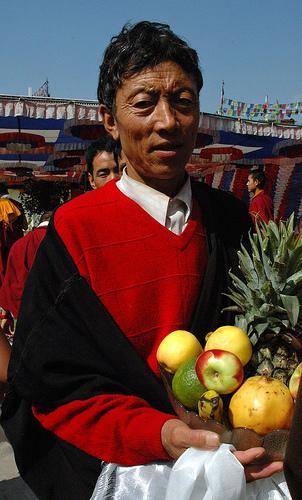
The Symbol of THE WAY (#5 of 5)
Posted on: 05/29/2009 15:53

Gospel: Mark 15:1-39
As soon as it was morning, the chief priests held a consultation with the elders and scribes and the whole council. They bound Jesus, led him away, and handed him over to Pilate. Pilate asked him, "Are you the King of the Jews?" He answered him, "You say so." Then the chief priests accused him of many things. Pilate asked him again, "Have you no answer? See how many charges they bring against you." But Jesus made no further reply, so that Pilate was amazed. Now at the festival he used to release a prisoner for them, anyone for whom they asked. Now a man called Barabbas was in prison with the rebels who had committed murder during the insurrection. So the crowd came and began to ask Pilate to do for them according to his custom. Then he answered them, "Do you want me to release for you the King of the Jews?" For he realized that it was out of envy that the chief priests had handed him over. But the chief priests stirred up the crowd to have him release Barabbas for them instead. Pilate spoke to them again, "Then what do you wish me to do with the man you call the King of the Jews?" They shouted back, "Crucify him!" Pilate asked them, "Why, what evil has he done?" But they shouted all the more, "Crucify him!" So Pilate, wishing to satisfy the crowd, released Barabbas for them; and after flogging Jesus, he handed him over to be crucified. Then the soldiers led him into the courtyard of the palace (that is, the governor's headquarters); and they called together the whole cohort. And they clothed him in a purple cloak; and after twisting some thorns into a crown, they put it on him. And they began saluting him, "Hail, King of the Jews!" They struck his head with a reed, spat upon him, and knelt down in homage to him. After mocking him, they stripped him of the purple cloak and put his own clothes on him. Then they led him out to crucify him. They compelled a passer-by, who was coming in from the country, to carry his cross; it was Simon of Cyrene, the father of Alexander and Rufus. Then they brought Jesus to the place called Golgotha (which means the place of a skull). And they offered him wine mixed with myrrh; but he did not take it. And they crucified him, and divided his clothes among them, casting lots to decide what each should take. It was nine o'clock in the morning when they crucified him. The inscription of the charge against him read, "The King of the Jews." And with him they crucified two bandits, one on his right and one on his left. Those who passed by derided him, shaking their heads and saying, "Aha! You who would destroy the temple and build it in three days, save yourself, and come down from the cross!" In the same way the chief priests, along with the scribes, were also mocking him among themselves and saying, "He saved others; he cannot save himself. Let the Messiah, the King of Israel, come down from the cross now, so that we may see and believe." Those who were crucified with him also taunted him. When it was noon, darkness came over the whole land until three in the afternoon. At three o'clock Jesus cried out with a loud voice, "Eloi, Eloi, lema sabachthani?" which means, "My God, my God, why have you forsaken me?" When some of the bystanders heard it, they said, "Listen, he is calling for Elijah." And someone ran, filled a sponge with sour wine, put it on a stick, and gave it to him to drink, saying, "Wait, let us see whether Elijah will come to take him down." Then Jesus gave a loud cry and breathed his last. And the curtain of the temple was torn in two, from top to bottom. Now when the centurion, who stood facing him, saw that in this way he breathed his last, he said, "Truly this man was God's Son!"
Epistle: Philippians 2:5-11
Let the same mind be in you that was in Christ Jesus, who, though he was in the form of God, did not regard equality with God as something to be exploited, but emptied himself, taking the form of a slave, being born in human likeness. And being found in human form, he humbled himself and became obedient to the point of death-- even death on a cross. Therefore God also highly exalted him and gave him the name that is above every name, so that at the name of Jesus every knee should bend, in heaven and on earth and under the earth, and every tongue should confess that Jesus Christ is Lord, to the glory of God the Father.
I
We began this series on symbols of transformation with a reading from the lectionary that described Jesus emerging from the Waters of the Jordan, with the Spirit gently descending upon him like a dove, and driving him into a Fiery encounter in the desert. When, after 40 days he emerged from the desert, he began the fruitful ministry in Galilee, which eventually became Christianity. And today, as we approach the end of this season of Lent, the lectionary challenges us with the words of St. Paul to “let this same mind be in us, which was in Christ.”
Over the past five Sundays, you have been patiently listening as I have made what feels to me like a remarkable claim:
-
That if we look deeply into the eyes of this person, Jesus of Nazareth, as he is portrayed in the Christian scriptures, and allow him to speak to us, we can know his mind, even now, in this present moment of our lives.
I've suggested that this is possible because there is a pattern that we can recognize within his words and his silences, within his actions and his choices to not act.
It is a pattern that was awakened in the hearts and minds of his disciples through the love relationship that they shared with him – through the tones of his voice as he spoke personally to each one of them, through the qualities of his touch as he embraced each one, in his and her uniqueness, and through the mysterious way that, in his presence, they found that their suffering ceased, even though life still had its inevitable “ups and downs.”
It is a pattern that resonates within us, because it has always been there in the depths of our hearts and minds, whether we have recognized it or not, whether we have ever been formally baptized, and churched, or not.
II
I have suggested that this pattern within the life of Jesus is a symbolic pattern. ...that we can only begin to talk about this pattern through sacred symbols that can take us beyond the limits of language.
Often we understand ourselves and our lives through ordinary (common sense) words, but that is like seeing ourselves through a dark and dusty piece of glass; who we really are becomes obscured. But when we begin understanding ourselves through sacred symbols, it is like looking into a God-sent mirror that reflects a deeper truth about who we are and the nature of our lives in this world.

The pattern that we can recognize in the life of Jesus is not a body of doctrinal propositions, or beliefs. It is not even a set of values or a cluster of feelings... or a list of actions to do. It is something even more primal and powerful: A pattern of sacred symbols, which, by their very nature, can transmit to us a truth that is beyond words.





Water, Spirit, Fire, and Fruit belong together. They need one another. They fit together like the pieces of a puzzle to form a symbolic whole, that represents a whole human being.
Together these symbols transmit into our lives, a transforming experience of that Divine Mystery we call 'God.'
Whether the present moment of life that we find ourselves in is an “up” moment, or a “down” moment, or an “in between” moment, these sacred symbols orient and re-orient our hearts and minds to a very simple Way.
A Way of moving in life that is the same Way that Jesus moved. It is a Way of continual turning... Out of the lie of being unlovable... Into the truth of being the beloved child of God.
(Do you notice that the “lie of being unlovable” is easier to see than the “truth of being a beloved child of God” ? Why is it that we almost have to stand on our heads to see the truth sometimes?)
Out of the lie of being unlovable... Into the truth of being the beloved child of God. Over and over again, from one context to another and another, through the “ups” and the “downs” and the “in-betweens”.
That simple turning movement is the inner expression of our baptismal vows (renunciation & affirmation).
But although it is simple, that basic movement turns out to be what makes all the difference in this life. It turns out to be the inner dynamic of life itself, the force that allows us to move forward on our spiritual journey, to fulfill the purpose for which we were created. That simple movement is the Way of Christ.
It is the symbolic pattern that we find over and over again in the scriptures.

It is the way that the Mind of Christ continually moves within us, continually surrendering to the Divine as Water, and Spirit, and Fire, continually bearing divine fruit.
Continually moving out of the lie, which says that we and those around us are unlovable... continually moving in to the truth that we are all part of the beloved family of God.

It is the movement of the liturgy: in all of its prayers and hymns, rituals and sermons. It is the mission of the Church in this world. It is our Life Program. The message that we are all called to live.
And it is a Way, with remarkable flexibility.

More flexibility than we are often comfortable with.
It easily accommodates unimaginable diversity, because it emerges from the Source of all diversity. And so, it is a Way with many different paths.

This means that no one can boast... no one has a monopoly on the Divine or on sanctity.

It means that the Jews, the Buddhists, the Muslims, the Atheists, the Hindus are all part of the family.

And they may well help Christians of all varieties to better understand and walk this Way.

Just as we may well be able to help those from other wisdom traditions by sharing our Christian experiences with them.
III
But, although this Way is more flexible than we can possibly imagine, we must remember that...

...it is neither wishy-washy, nor vague, nor indulgent when it comes to confronting the great lie of unlovability.... which wears so many masks... and can so very easily afflict our minds... and start the vicious cycle of violence spinning within and around us.

On this Palm Sunday, we remember most of all that this Way of Christ, is a Way that, in the mind of Jesus, was worth dying for.
I will close by offering you a question for reflection that is suggested by today's reading in Philippians: Do you have enough experience of this Way of Christ to judge for yourself whether it is really good enough to die for?
Whatever responses to that question may emerge as you reflect on it, rest assured that no response you could ever make will condition a loss of love. For we are grounded in a love that never dies.
Thanks be to God.
© WonderCafe. All Rights Reserved
Brought to you by the people of The United Church of Canada
Opinions expressed on this site are not necessarily those of WonderCafe or The United Church of Canada











